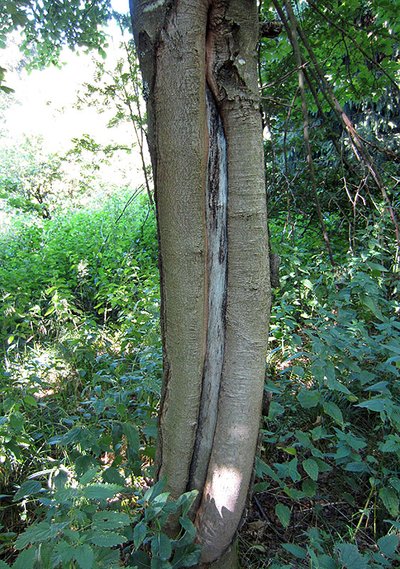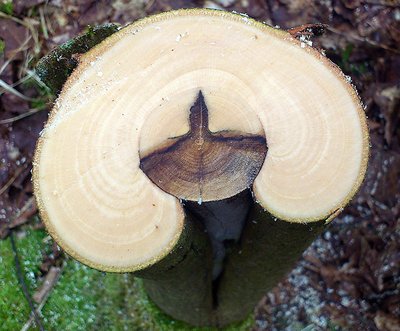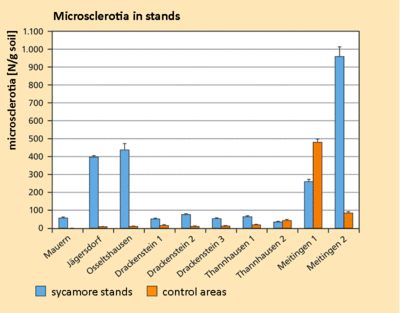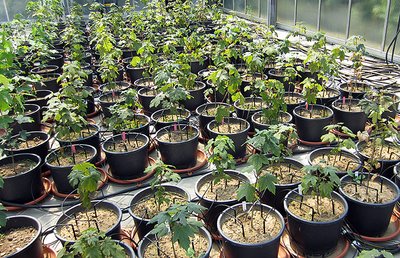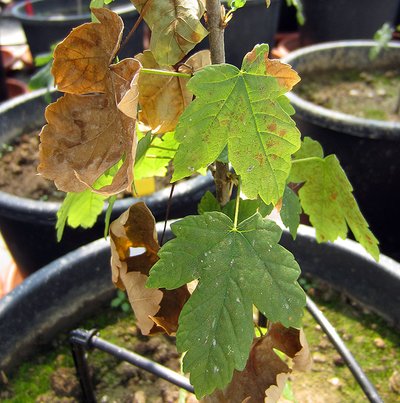The soil-borne fungus Verticillium dahliae affects several hundred plant species – including herbaceous plants and more than 70 woody plant species. Sycamores in particular are considered to be highly susceptible, but lime, elm and ash are also vulnerable to it. Monocotyledonous plants and conifers are not affected. The pathogen causes serious economic losses for the growers of olives, cotton, hops and strawberries. These losses have steadily increased since the mid-1990s.
Symptoms in sycamore trees
In shrubs, the wilting and dieback of leaves and shoots are typical symptoms of this disease. The trees may subsequently die. This is more likely to be the case with young shrubs. Often the infected trees recover in subsequent years.
Verticillium dahliae causes cracks in the trunks of sycamore trees, from which pronounced trunk necroses then develop (Fig. 1). Characteristic brownish to olive green discolouration is clearly visible in the cross-section (Fig. 2). In recent years, more and more necroses caused by Verticillium dahliae have been diagnosed in the lower trunks of sycamore.
80 % of trunk cracks caused by Verticillium in sycamore avenue trees developed during periods of hot and dry weather between May and September. The cracks often heal again over the years. They do however provide entry points for wood-rotting fungi.
Microsclerotia in the soil
Microsclerotia are the long-lived resting structures of fungi. Verticillium dahliae is widespread in the soil in this form. The fungus invades the trees through the root system, produces spores there, and spreads through the tree’s vascular system. Tyloses may form in the vascular tissue and block the water-conducting channels. In extreme cases - probably influenced by additional abiotic factors - cracks in the trunk occur. In tree species with diffuse pores such as sycamore, the blockages in the xylem may also have a negative effect on the flow of water in the tree in subsequent years.
Microsclerotia develop in the wilted and necrotic leaves and leaf stalks. When the leaves fall, the microsclerotia are released into the soil as the plant tissue decomposes, and may persist in the soil for many years. The level of fungus contamination in the stands thus increases still further. To this day it has not been determined whether and in what concentration Verticillium dahliae occurs naturally in forest soils.
Scientific investigations in the forest
Monitoring was carried out throughout Bavaria to establish where the Verticillium wilting and trunk necroses occur in sycamore stands. The problem mainly affects younger populations planted in afforestation or reafforestation projects. An average of 36 % of the sycamores in the ten core experimental areas that were established developed a crack in their trunks (on average 80 cm long and 5 cm wide). These necroses occurred on all sides of the trunk, and sometimes there were also several cracks in one tree. This precludes the possibility of sun and frost causing the damage.
Concentration of pathogens in the soil
In ten sycamore stands, composite soil samples were taken and the concentration of the pathogens was determined. According to the classification system used in standard practice, a stand is classified as severely contaminated when 15 sclerotia are found per gramme of soil.
The sampling showed that Verticillium dahliae was present in almost all stands. The rates of contamination in the sycamore stands were sometimes very high, so that the risk of trees being infected was also very high. In two stands, pathogen concentrations of around 400 sclerotia per gramme of soil were found, and in one afforestation area with sycamores there were as many as 960 (Fig. 3).
In the ten stands in the study, there were no apparent correlations between the concentration of the pathogens in the soil and the rate of occurrence of necrosis. Astoundingly, the fungus was also found to be present in the comparison areas without susceptible tree species.
The influence of drought stress
In order to investigate the influence of drought stress on the damage symptoms, an experimental semi-field area (under a glass roof) was established under controlled conditions (Fig. 4). During potting of the trees, the plants were infected with the fungus by dipping the bare roots in a spore suspension. Soil water content sensors were set up next to both the infected and the non-infected plants. A controlled irrigation system was used to subdivide these two groups of plants into three different soil water content groups each (drought stress variants):
- good water supply
- moderate water supply
- poor water supply
As early as the first vegetation period, the infected plants developed more typical wilting symptoms than plants in the control groups (Fig. 5). The significantly reduced rate of photosynthesis in the infected plants was particularly striking. As to be expected, the rate of photosynthesis decreased in all plants with decreasing soil water content. The rate of photosynthesis was significantly lowest in the infected plants under drought conditions. The results confirm that drought stress worsens the leaf wilt symptoms in plants infected with Verticillium dahliae.
Summary and outlook
For some years now, trunk necroses caused by the soil-borne fungus Verticillium dahliae have been observed in sycamore trees. In the damaged sycamore stands in the study, around one third of the trees showed signs of trunk necroses. In almost all stands - both sycamore and control stands - Verticillium could be shown to be present by means of its microsclerotia. A correlation between the level of contamination of the soil and the severity of the damage to the trunk is not discernible. Rather it can be assumed that Verticillium occurs naturally in many soils. In the study, the frequency and severity of the symptoms of wilt increased with drought stress; the rate of photosynthesis was also reduced.
It is not possible to treat this pathogen in the forest. As little is known about the longer-term development of this harmful pathogen in forest stands, monitoring of the affected sycamore populations must be continued.

